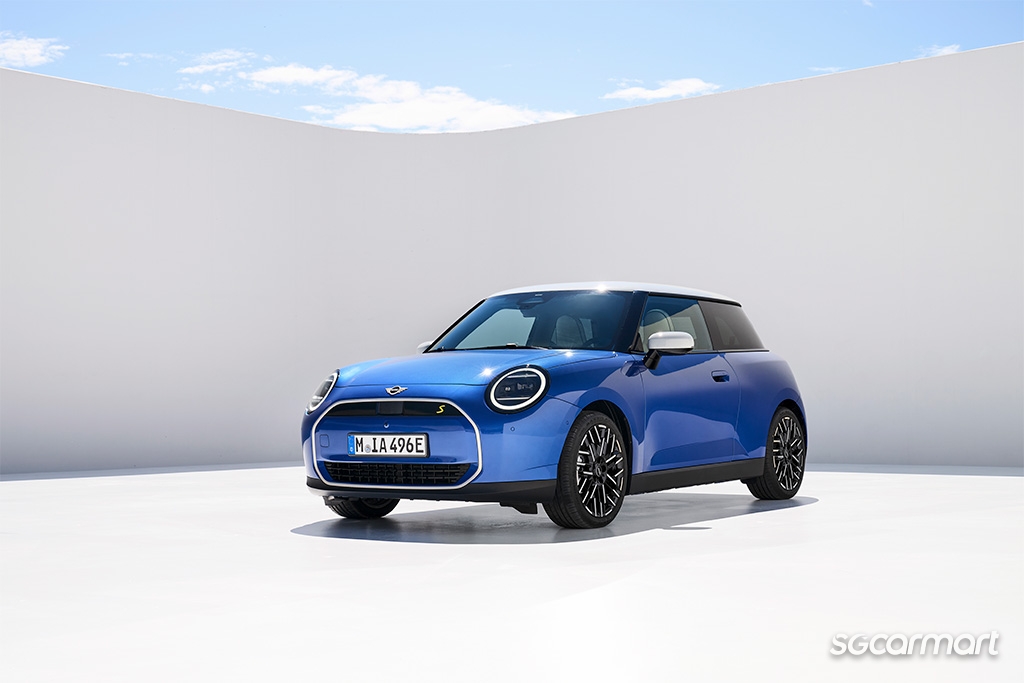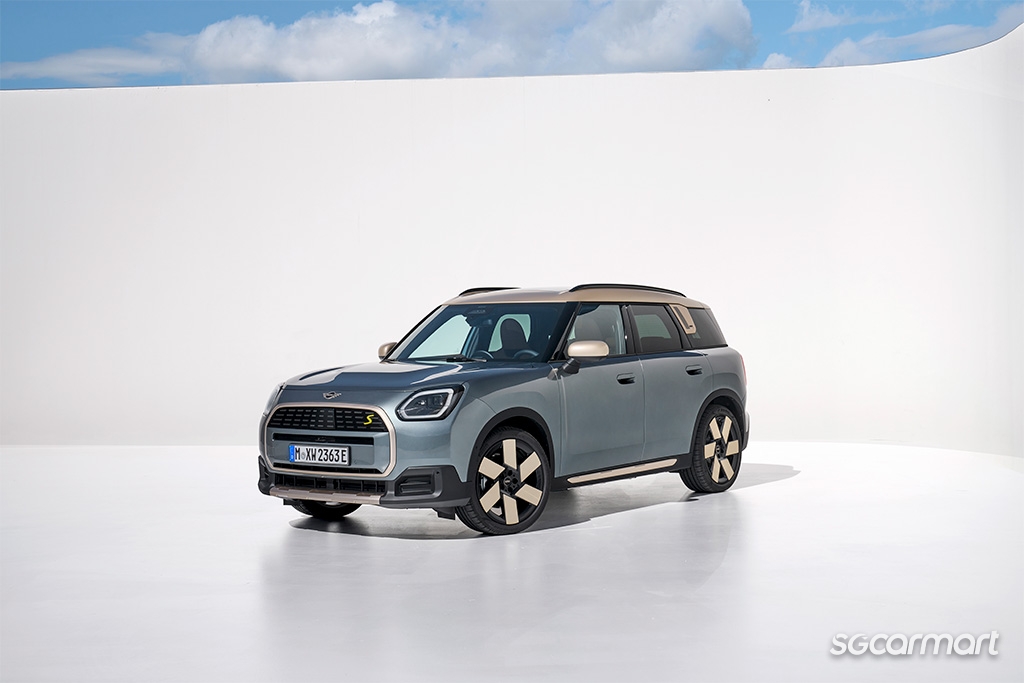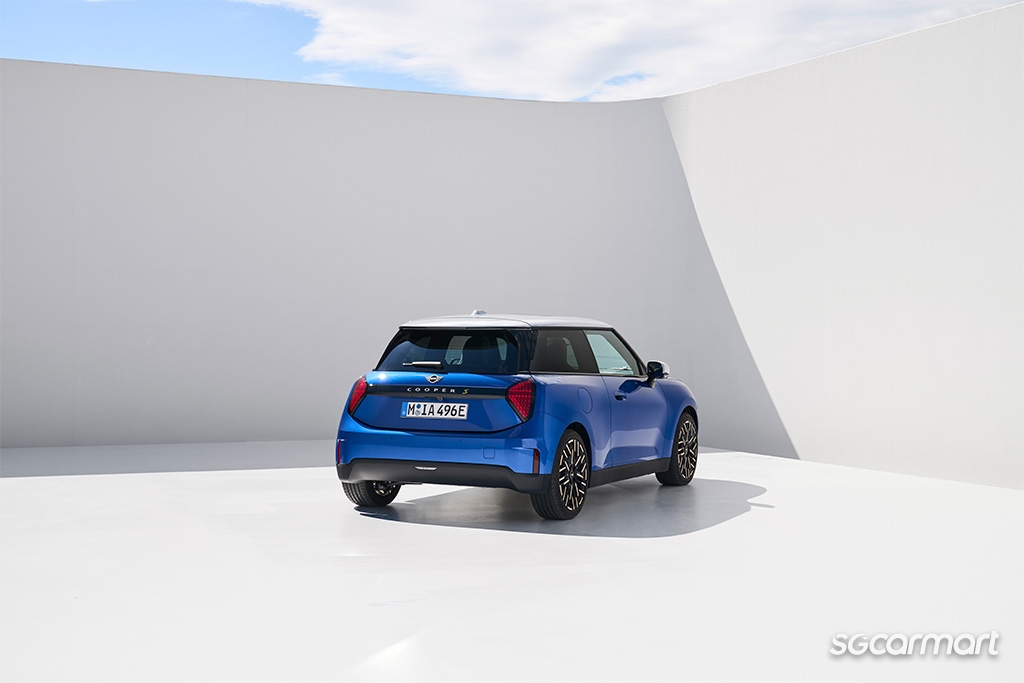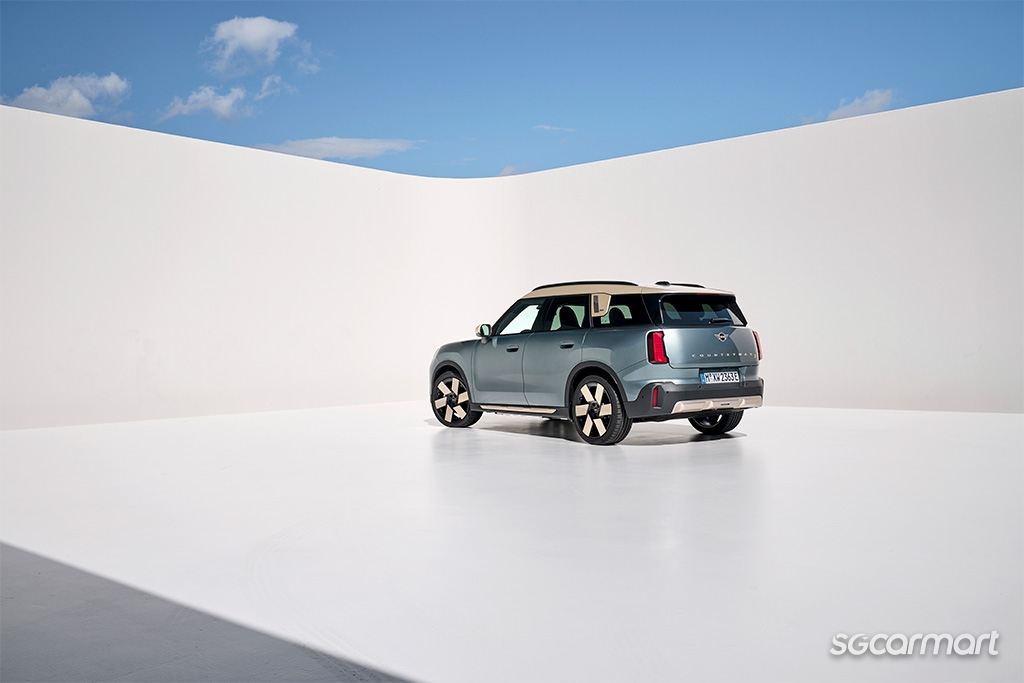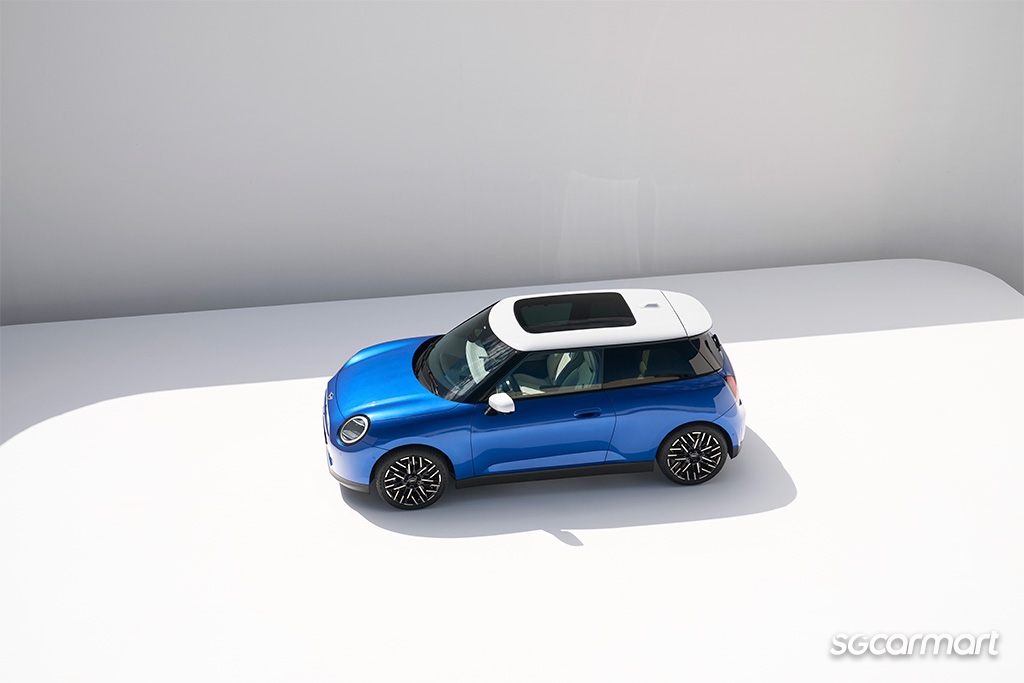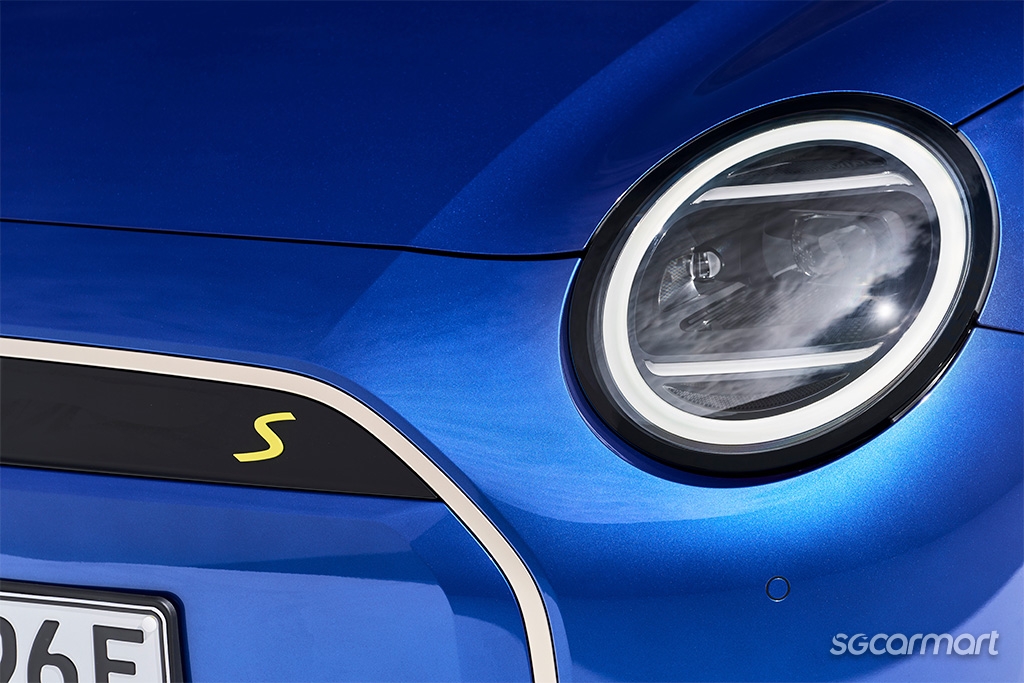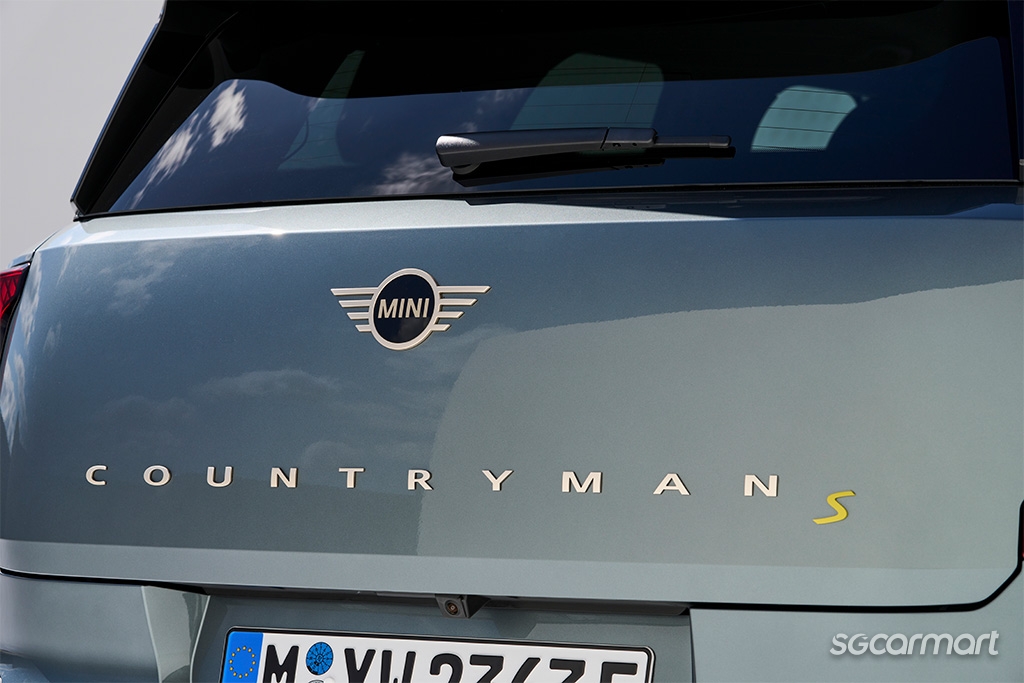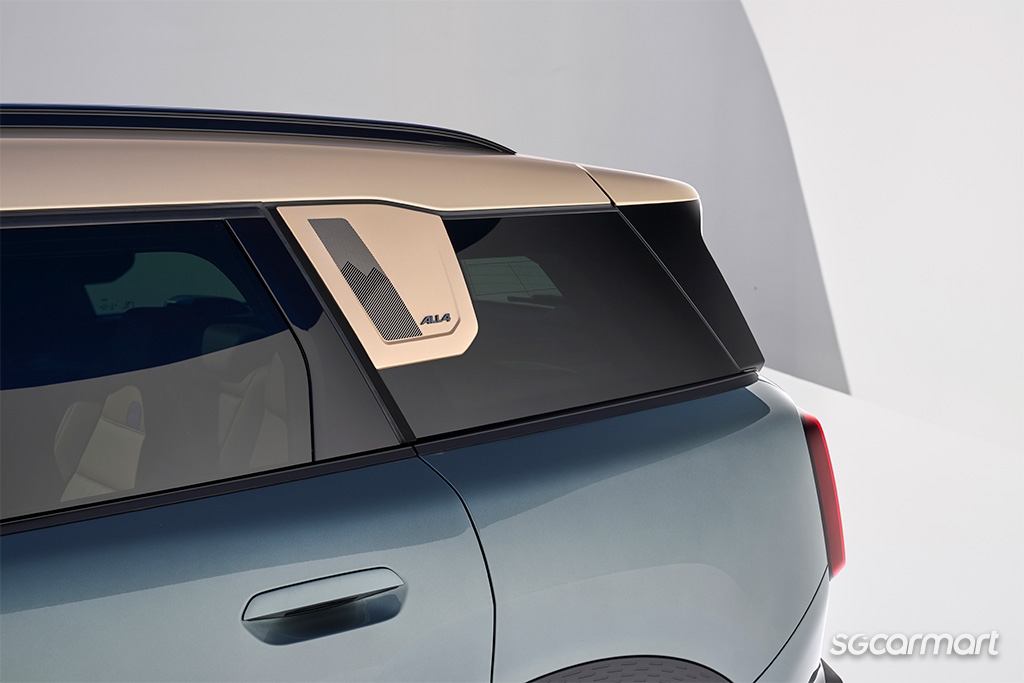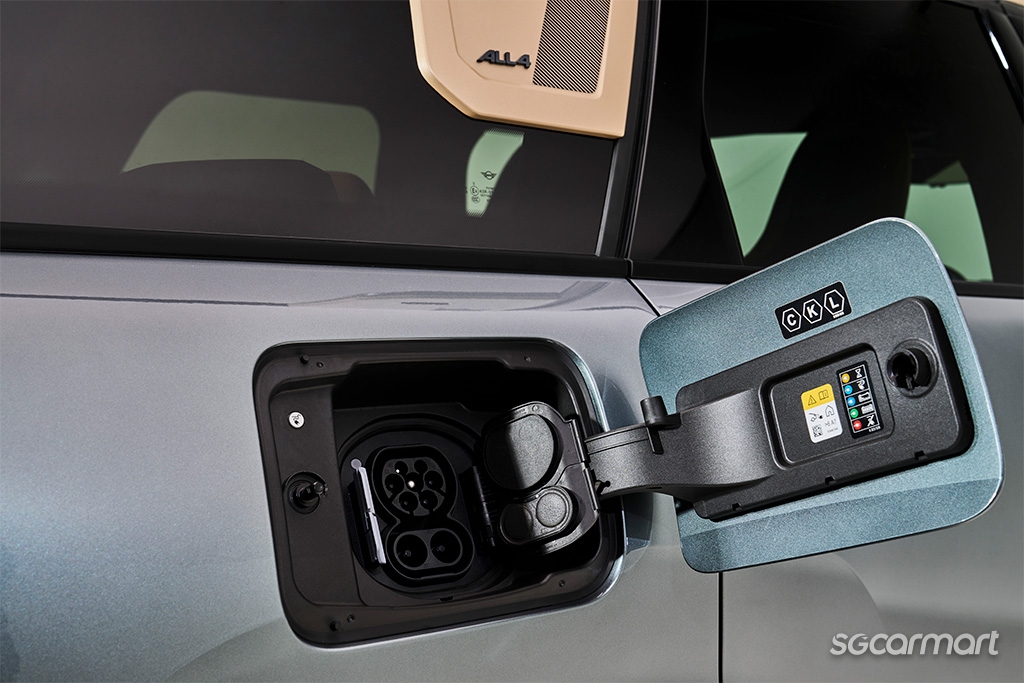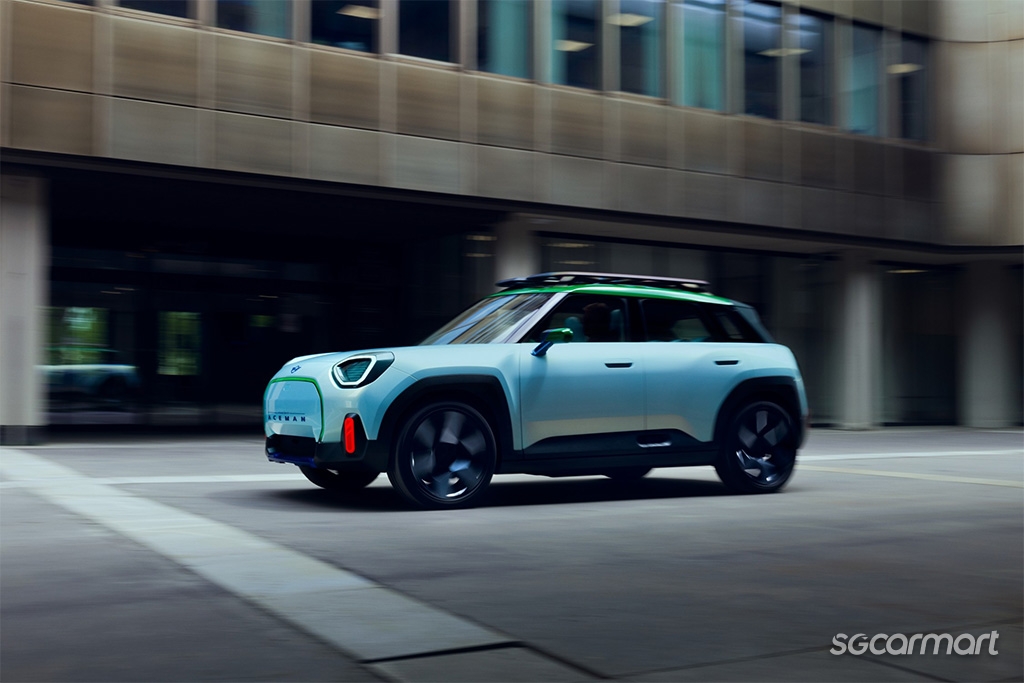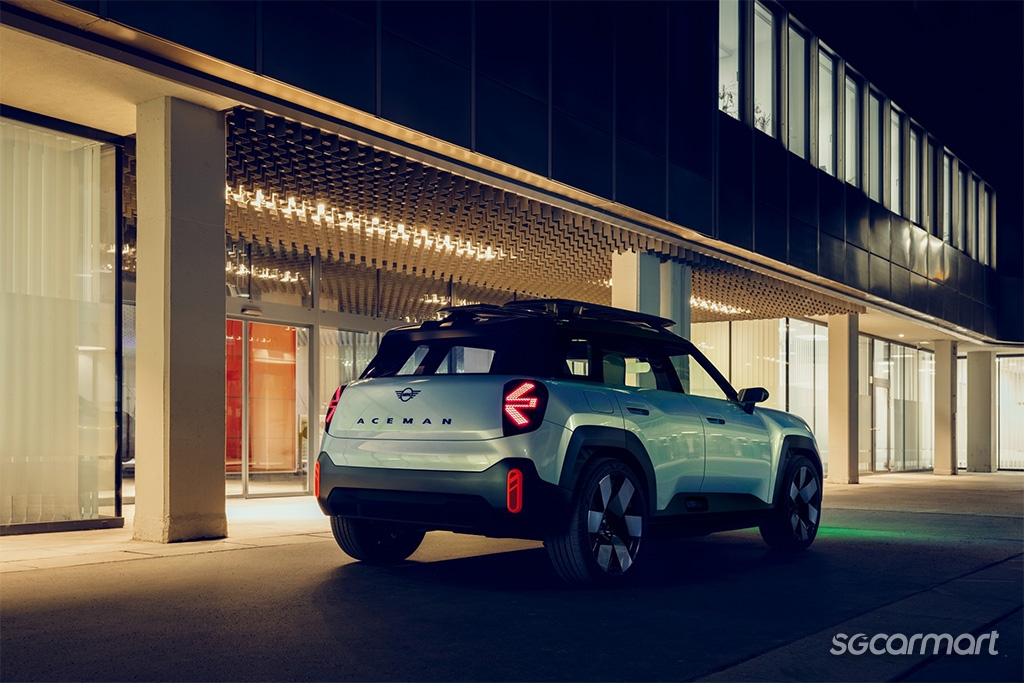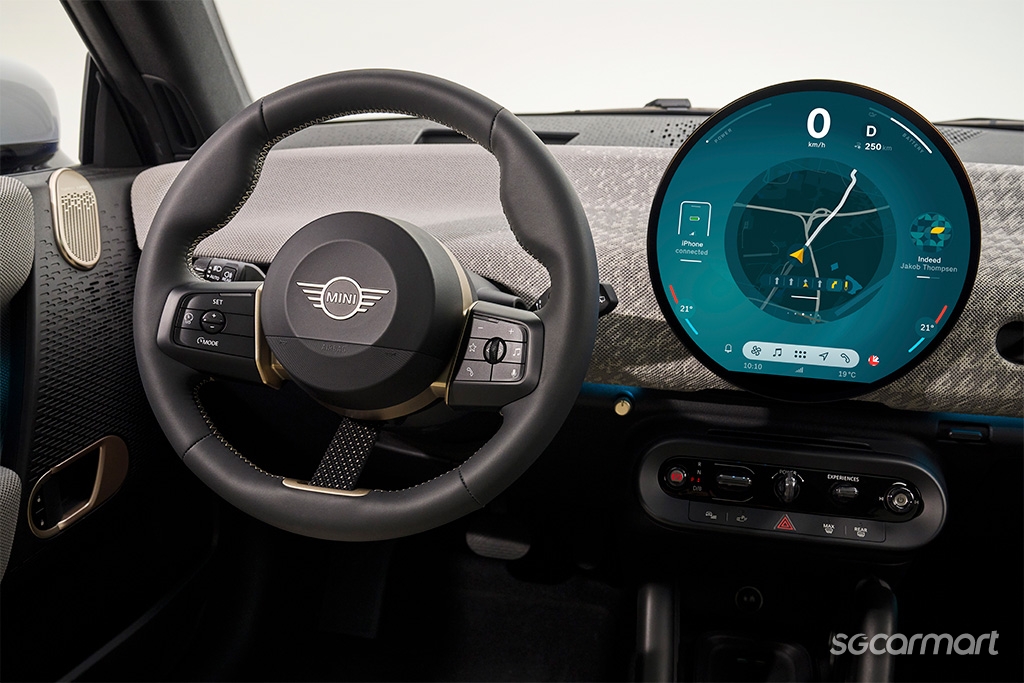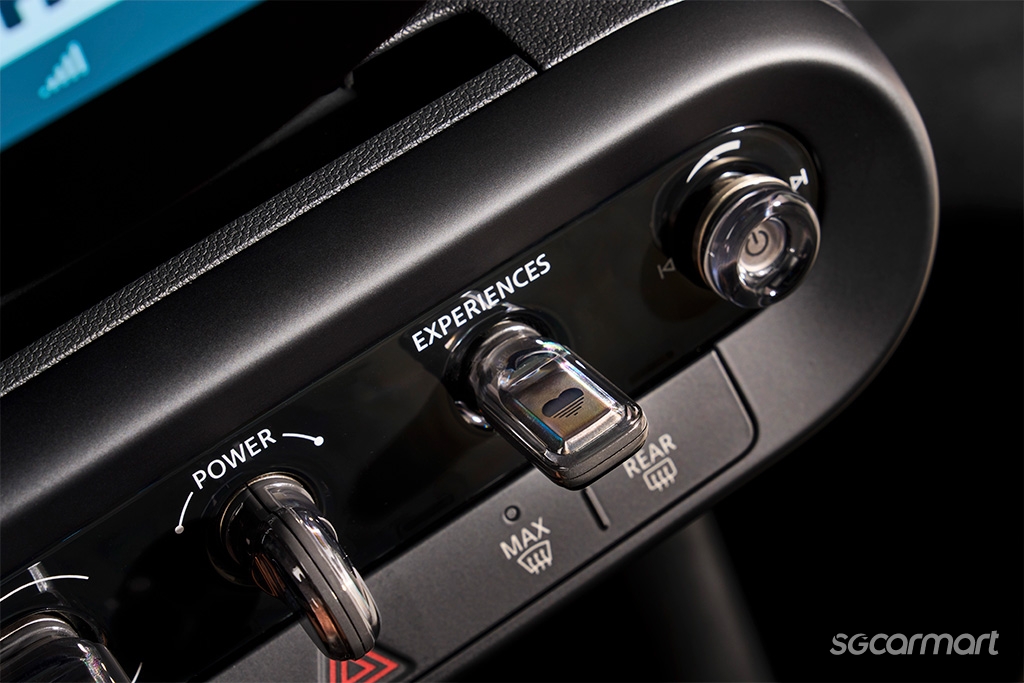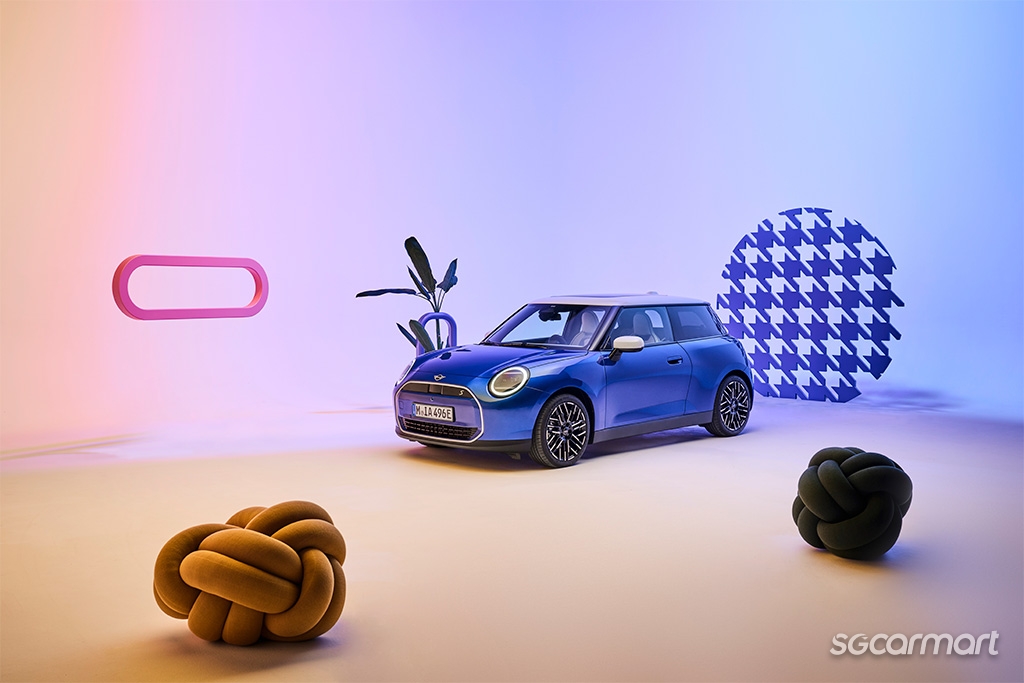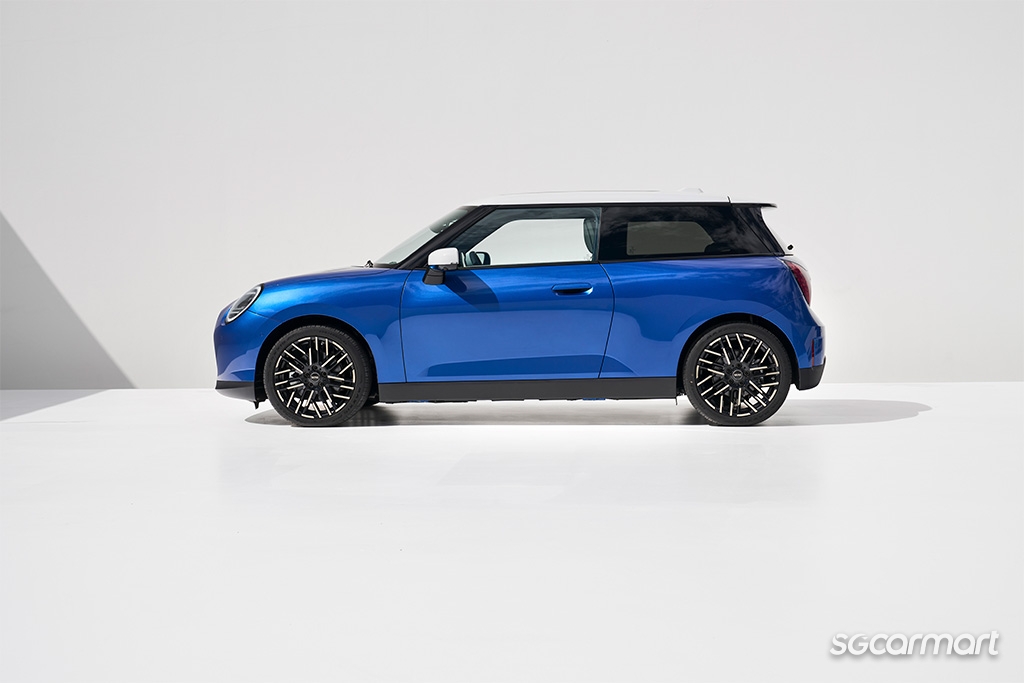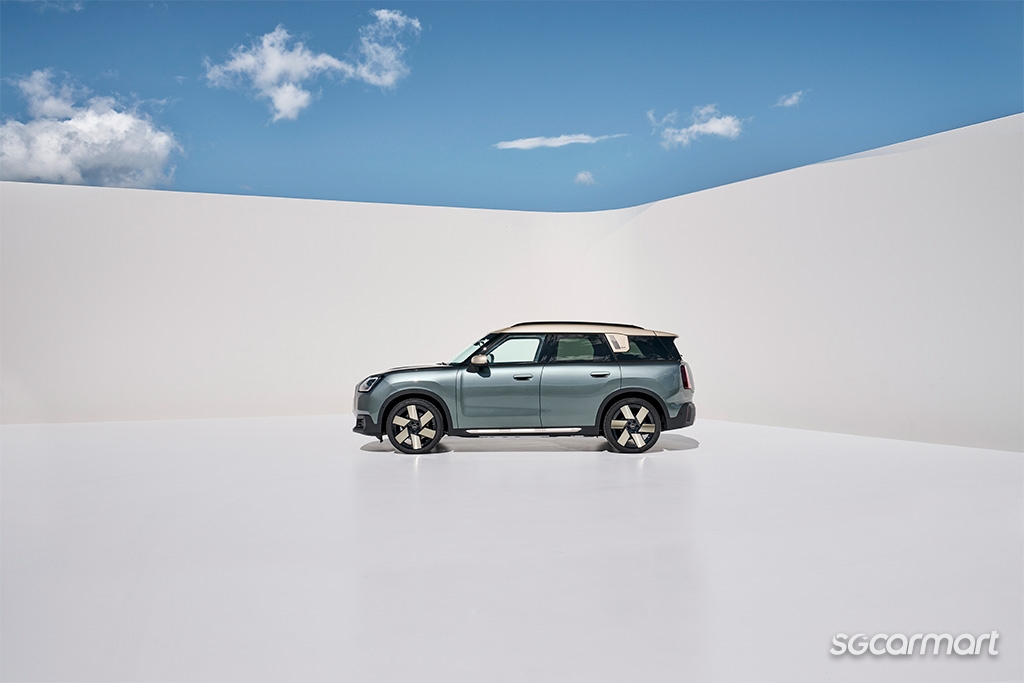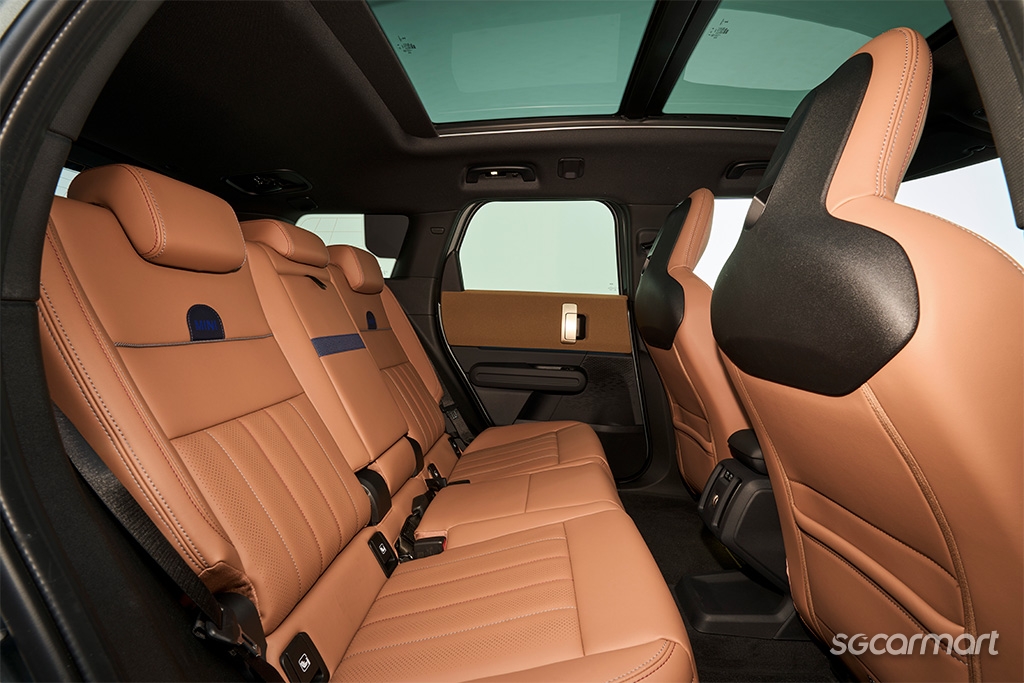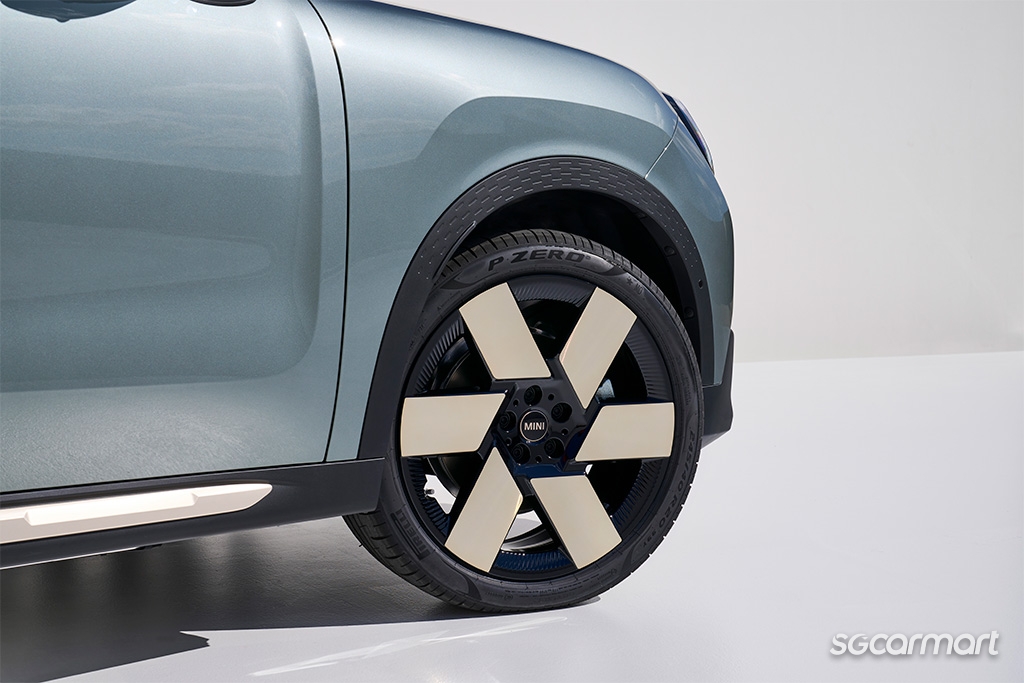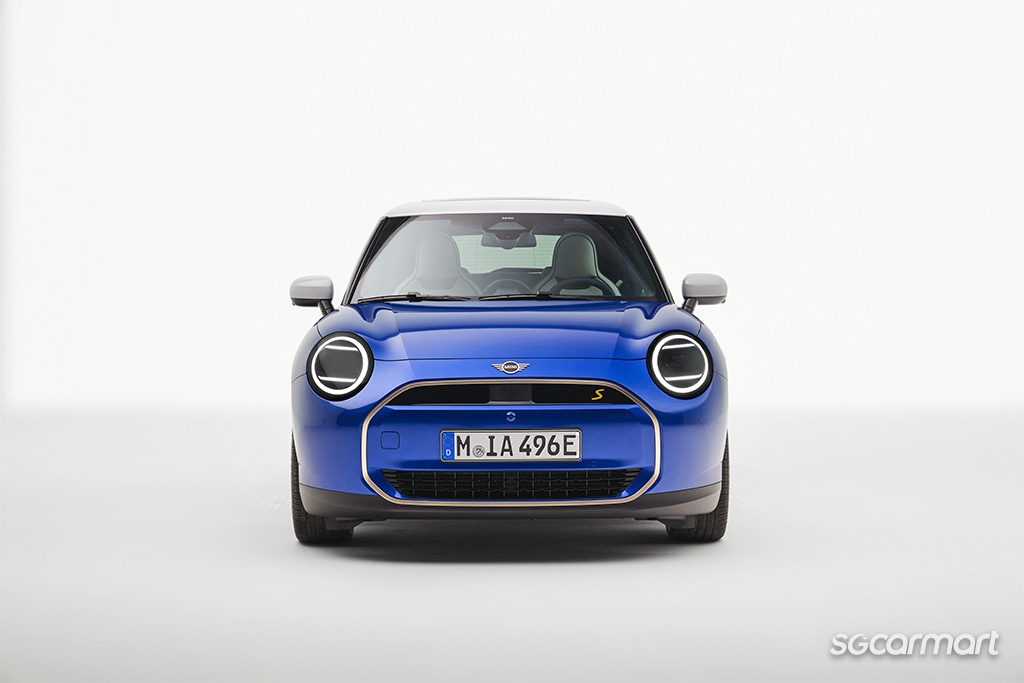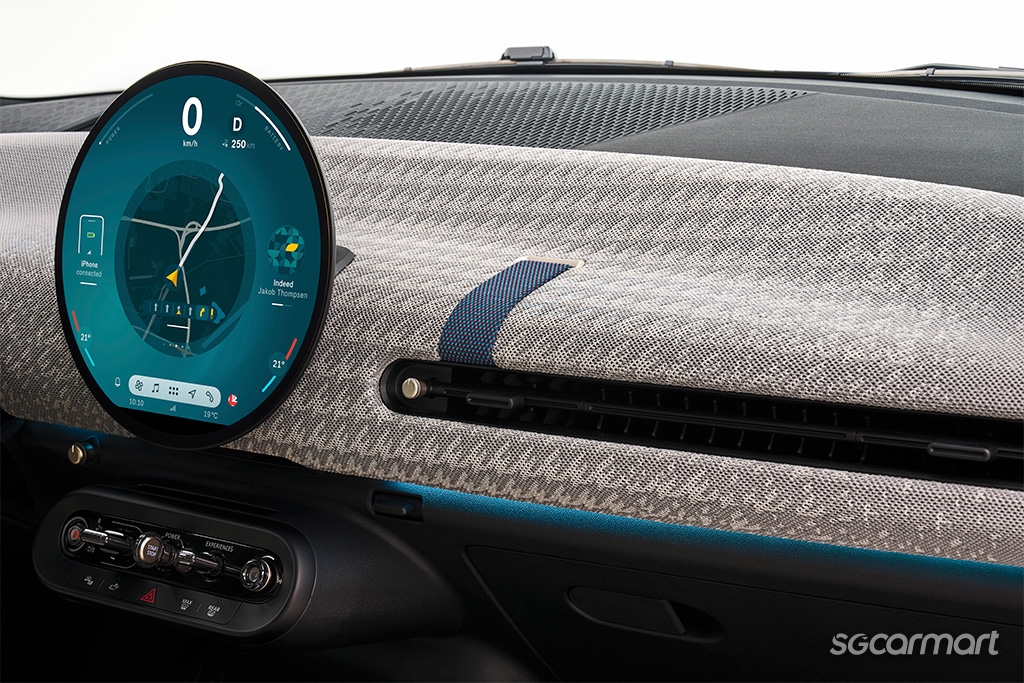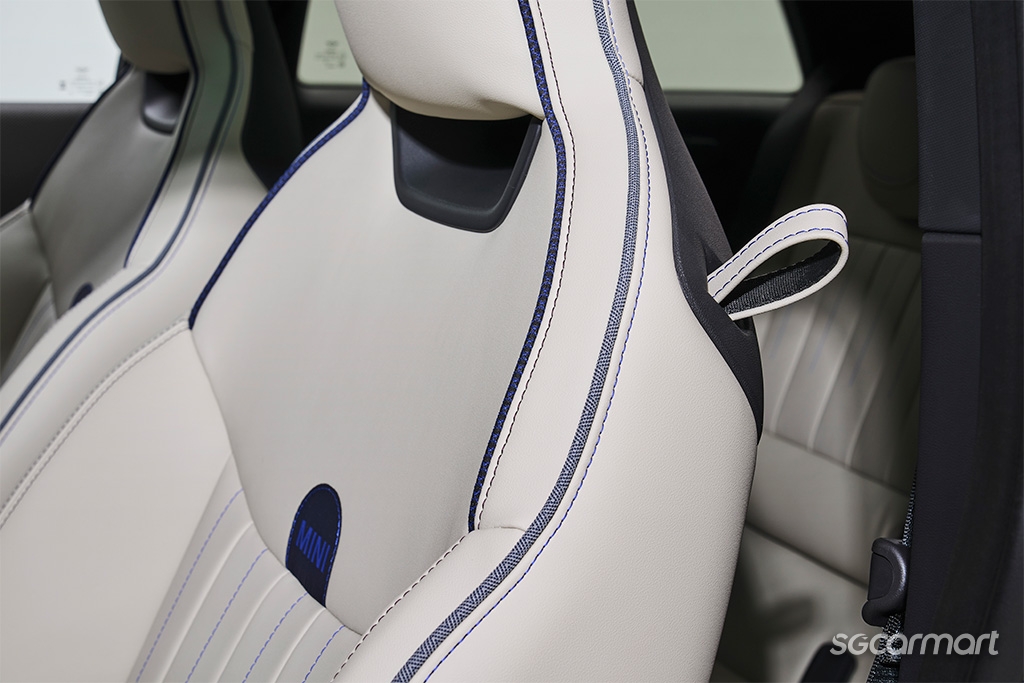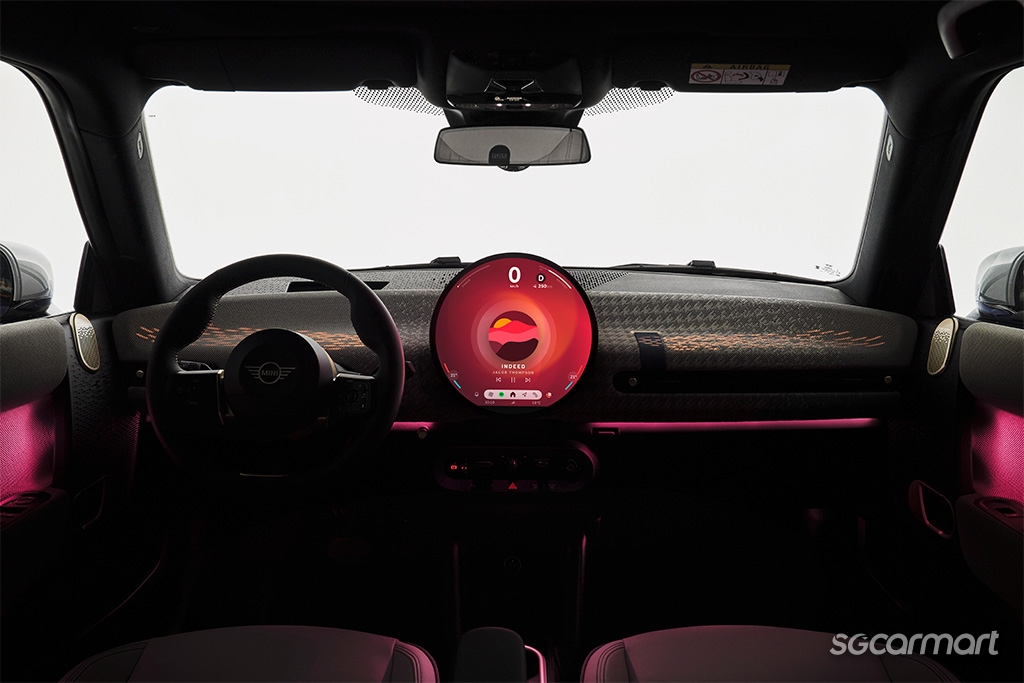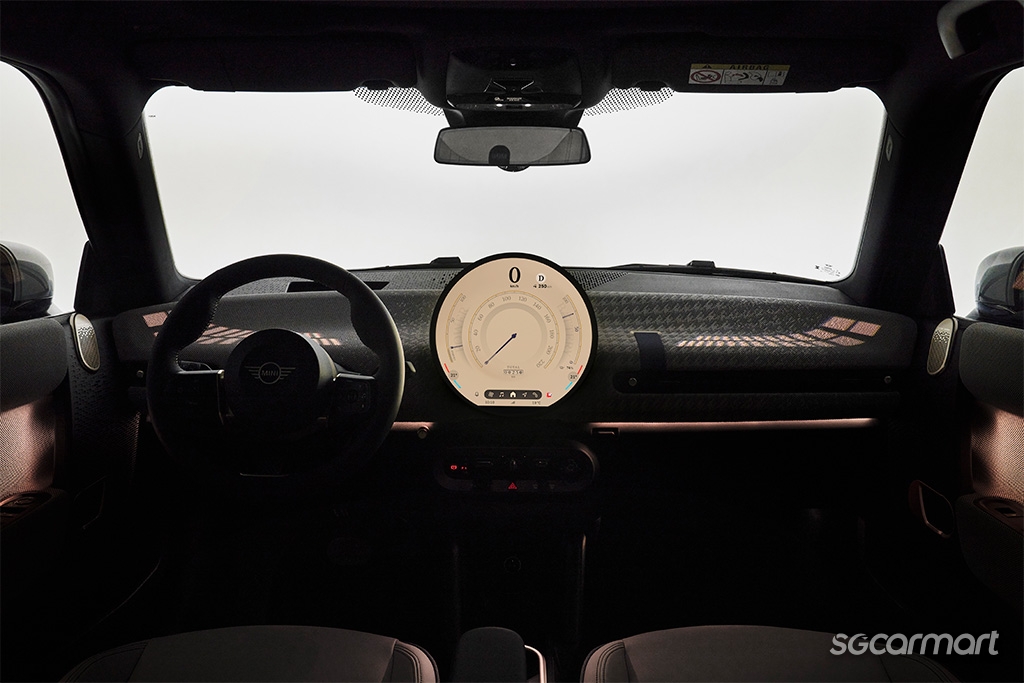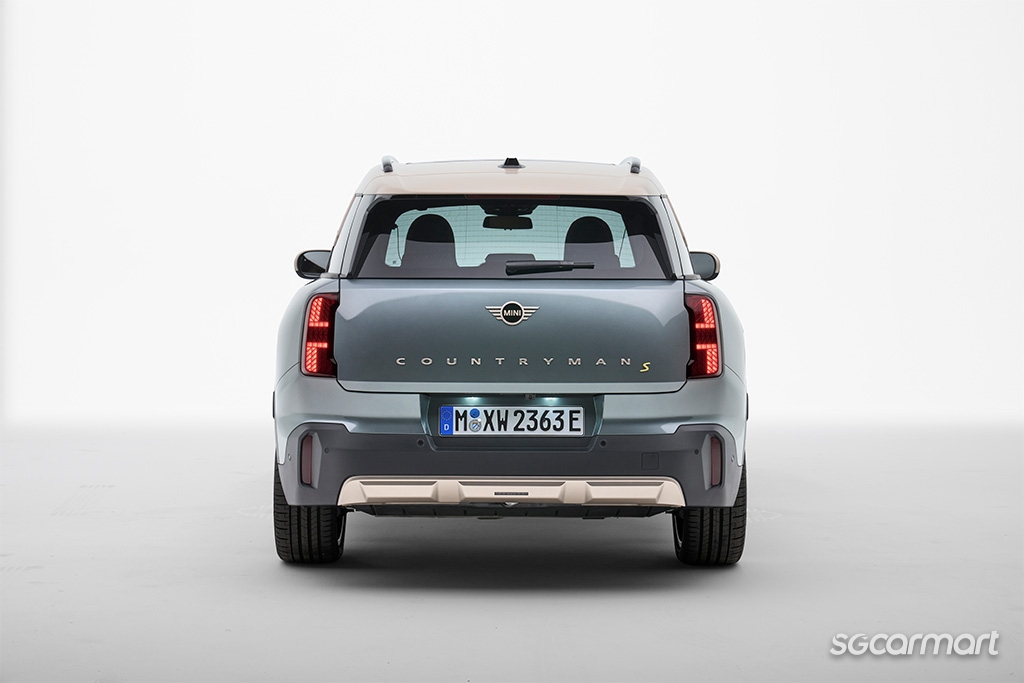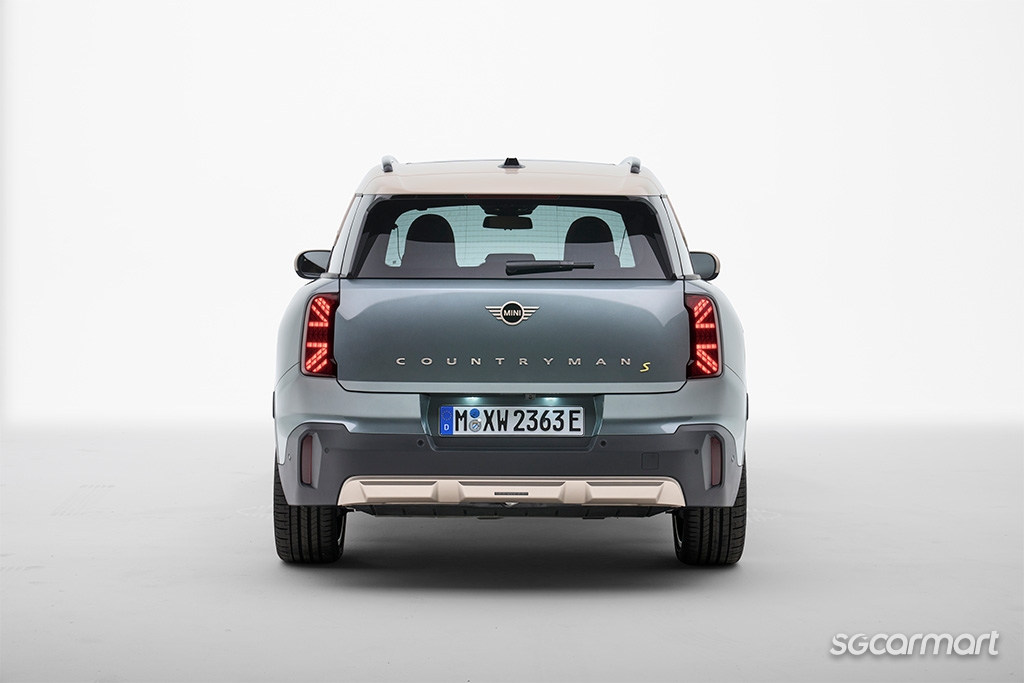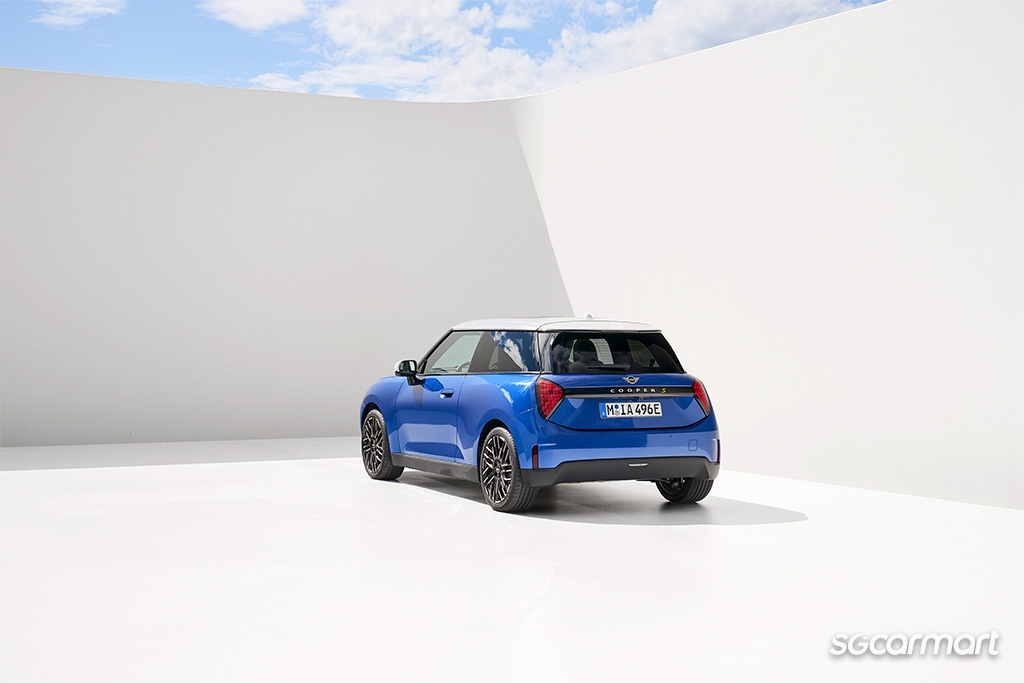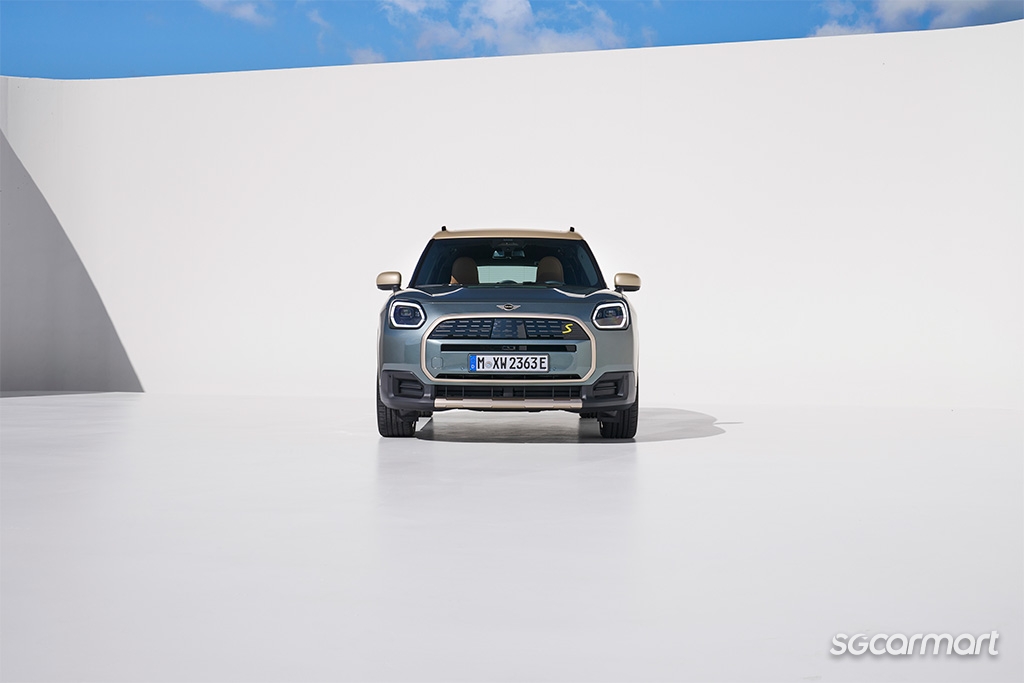First look: 7 things you should know about MINI's new family
01 Sep 2023|4,001 views
True to the playful spirit of its brand, MINI has also clearly had some fun in recent months teasing us about its next generation of cars.
Since May this year, we've gotten details on the powertrains of the all-new Cooper Electric and Countryman Electric, had a detailed look at their interiors, and even gotten to explore the new digital worlds that they will soon unlock.
Now, however, everything is finally being unveiled in full.
The new MINI Cooper Electric and Countryman Electric are part of the trio of all-electric models that will take MINI into a new era of emissions-free motoring
Ahead of their debuts at the Munich Auto Show, we actually got the chance to see the cars up close at a special preview event, while hearing firsthand from the team behind the instantly recognisable, yet also intensely forward-facing machines seen in these pictures.
Here's where the 'playfulness' is perhaps put on pause just momentarily. As an idea of the gravity with which MINI sees this new generation, the company is going as far as to liken it to the Neue Klasse cars that parent company, BMW, will only debut in 2025.
MINI's Neue Klasse, here today: The two models are already production-ready, and should be hitting our roads in the very near future
"The difference with MINI is that [although] this is our Neue Klasse, it's already here - and it's already a version that will come to the market as you see it today," Stephanie Wurst, Head of the MINI Brand, told us. Amidst the tsunami of information now surging forth about these new cars, here are seven key facts we took away about MINI's new generation of charismatic (yes) cars.
1) Naming: 'Cooper' now refers to a model range - not a powertrain variant
As a quick refresher, there have thus far been four distinct powertrain variants for (almost) every MINI model: The entry-level 'One', the slightly more powerful 'Cooper', the warmer 'Cooper S', and finally, the red-hot 'John Cooper Works'.
When the new MINI family hits our roads, however, 'Cooper' will no longer be a powertrain variant. Instead, 'MINI Cooper' will solely refer to the original, iconic hatchback bodystyle that has always laid at the centre of the MINI brand.
Overhauling the model naming convention makes sense - and the move is welcome. As the MINI range grew over time - not just in terms of individual models, but also power variants - so too have model names become quite clunky, and slightly difficult to discern immediately.
Case in point: 'MINI John Cooper Works' refers to the hotted up version of the iconic MINI Hatch; 'MINI John Cooper Works Clubman', to the wagon. Unless you're an ardent fan of the brand, however, this ordering format may make 'Clubman' sound like the variant rather than the actual model.
There's also the confusing naming convention internationally for the firm's electrified cars thus far. MINI Cooper SE? That's the fully-electric MINI Hatch (named the MINI Electric in Singapore). MINI Cooper SE Countryman? That's the plug-in hybrid MINI Countryman.
Names are set to look cleaner and shorter now, and from what we understand, 'S' and 'John Cooper Works' will still remain as designations for the more powerful variants of each model.
2) Electrification is really taking off
Electrification used to exist on the periphery of the MINI range. The MINI Electric's (or MINI Cooper SE's) runaway success has somewhat obscured the fact that it remains the only fully-electric MINI that money can buy (the 999-unit, limited-run MINI Cooper SE Convertible doesn't technically count). As mentioned above, the only other electrified MINI came in the form of a plug-in hybrid Countryman.
Things are now set to change. At least three separate models in the new MINI family will be available fully-electric - including the MINI Cooper and MINI Countryman we caught at the preview.
We also already know that there will be two all-electric powertrain variants for both models. Respectively, the model ranges start with the Cooper E and Countryman E - but if it's more power you seek, you can step up to the more powerful Cooper SE and Countryman SE (which are actually the cars pictured here). The latter will even mark MINI's first all-electric, all-wheel drive vehicle, with dual motors capable of 308bhp.
Just as importantly, battery packs with larger capacities mean the new MINIs will also travel further on a single charge. The Cooper E and Cooper SE promise ranges of between 300 to 400km, while the electric Countrymans should manage up to 450km. "If you know our current range, you'll know that it's a big leap," Stephanie noted.
The final member of the trio spearheading MINI's electric future will take shape as the Aceman. While the Cooper and Countryman will still be offered with combustion engines, the Aceman will be a purely electric five-door crossover, sitting in between its two siblings in size.
On a slight tangent, those who've driven the current MINI Electric will know that its interior is differentiated by subtle but unmissable Electric Yellow accents to mark its electric status - on the gear level, Start/Stop button, and instrument cluster.
Pictured: The Aceman Concept, set to become the third all-electric member of the new MINI family. This will be a five-door, electric-only crossover, sitting between the Cooper and Countryman size
As a sign of how MINI is normalising electrification, we learned from the team in Munich that there will be no such interior differentiation between its electric and combustion-powered Coopers and Countrymans.
"In the current MINI lineup, we only have the MINI Cooper SE, [which is why there was] a clear differentiation", Christine Theiss, Head of Product Management, MINI User Experience, explained. "In the future, we will have so many electric models [that] differentiating this with a colour is no longer necessary… An electric car [will be] just another car."
Speaking of the interior…
3) A return to MINI's interior design roots - enabled by an unprecedented step forward in technology
As a response to the bubbling oil crisis that bulldozed the futures of many large petrol-guzzling cars, Sir Alec Issigonis' Mini was characterised by its ethos of 'Smart Simplicity'. A transversely-mounted engine, small footprint that saw the four wheels being pushed to the corners, and importantly, a focus on interior space and the interior itself all converged in the original car.
With an eye on the past, MINI says the new generation is taking the spirit of the original pioneer, and putting a modern spin on it, dubbed 'Charismatic Simplicity'.
Central to the refreshed philosophy is the MINI Interaction Unit, which consists of three key components that marked the original car: The steering wheel, toggle-switch control panel, and finally, the rounded speedometer - with a digital twist.
Whereas MINIs thus far have housed a rectangular infotainment screen within a larger circular casing, the new MINIs will debut a rounded, 240mm OLED display functioning as the infotainment screen. This is apparently the largest of its kind to ever be introduced in a car, and opens up a whole new digital canvas for MINI to tinker with UI/UX design of its MINI Operating System, which even includes cute digital avatars and eight 'Experience Modes'.
This is arguably MINI's most fully-realised take on how its classic, circular design elements can be interwoven with a modern cabin - and funnily, it's happened precisely because of unprecedented steps forward in the technology employed.
4) Smaller Cooper, larger Countryman
If the new MINI Cooper looks clean and modern, yet also strikingly familiar, your eyes are not playing tricks on you.
MINI says that among the qualities that it kept from the outgoing car were the "overall facial expression", and the proportions from the car's headlamps to its grille. But the new 3-Door Cooper manages something else one hardly expects from a new car in today's age: It's actually 13mm shorter than its predecessor.
With its shorter body and slightly longer wheelbase, MINI believes the new Cooper looks better proportioned than its predecessor
At the same time, MINI says it has still managed to extend the car's wheelbase, allowing the car to look better proportioned from the side, with its overhangs shortened yet again, and its wheels pushed even further out into the corners.
Things are quite the contrary with the Countryman. With its length increasing by 140mm, and its height, by 60mm over its predecessor, the all-new Countryman is also the largest that the model has ever been. Overall, you'll notice that it looks even boxier than before too, with a heavier reliance on rectangular shapes to give the car a rugged feel.
The Countryman's physical growth apparently allows MINI to cater to a new target group by offering more passenger and boot space
The decision to grow the Countryman again may sound controversial, but MINI says that it wants to offer those who love the brand a truly practical and spacious car - one, that will last families through different generations. "We can now cater to a new target group," Stephanie said, with the car offering "the chance to stay within the MINI brand, [even] with a broader family."
5) More sustainable than ever
The new generation of MINIs promise to be more sustainable than ever - and not simply because many of them will be fully electric too.
Instead, thorough effort has been made to incorporate recycled materials into the manufacturing process, all while keeping the same funkiness we associate with the brand's design DNA.
Recycled aluminium has been integrated into the wheel alloys, while chrome, as a material, has been completely eliminated on the exterior. Instead, the grille surround is painted over in a colour called 'Vibrant Silver'
This already announces itself on the outside, where the use of chrome has been completely eliminated. The 'grille' surrounds of the cars are painted over in a manner that's meant to resemble chrome - and using a colour MINI has called 'Vibrant Silver'. Meanwhile, wheel alloys on both cars will comprise a larger proportion of recycled aluminium.
On the inside, leather has been completely eliminated, and in this completely vegan space, 'vescan' seats are used instead. In addition, the variety of materials used has been reduced here - so that the manufacturing process, firstly, is less resource-intensive, and also to help the recycling of the vehicles when they eventually reach the end of their life cycle.
Another special feature you'll notice when climbing in? 2D patterns, knitted into the fabric covering the dashboard. "We've reduced a lot of elements in the MINIs, but we wanted to keep an element of warmth in the car with the 2D knit - it's made of recycled materials," Christine said.
6) Lighting!
On that note, if you think that the use of fewer materials means constricts visual variety and texture, you might want to think again.
Keen not to let sustainability spell a death knell for creativity, MINI has instead found the solution to customisability in a different source: Lighting.
This tactic is employed in a twofold manner. If the 2D-knit on the dashboards isn't fancy enough, putting the car into its various Experience Modes doesn’t just trigger colour-coordinated ambient lighting strips; it also projects various patterns onto the dashboard, to create an environment cohesive with the Mode you’ve selected.
Externally, the LED matrix taillights are also capable of displaying three separate patterns - based on the whims and fancies of the individual driver. This is meant to give the car a more multi-dimensional character.
The LED Matrix taillights on both cars feature three distinct lighting signatures that can be chosen by the driver
As Sebastian Kroess, Head of Interior Design at MINI, pointed out to us, "At the front of the car, the car welcomes you with a twinkle in the eyes - we took that quite literally, and found that really really fun."
7) Children of mixed heritage - more than ever
While Plant Oxford has always been the beating production heart of the MINI ecosystem, the brand's new cars will soon also be able to wear the proud label of being 'Made in Germany'.
It’s no surprise - Plant Leipzig has already been primed by the BMW Group as one of the core sites equipped for its fully-electric models, with its facilities primed for EV-manufacturing, and also already hooked up to rely completely on renewable energy. When the fully-electric MINI Cooper and Countryman officially enter production, they will mark the first time ever that MINIs are produced in Germany.
Fret not over the fate of Plant Oxford, though. The site will still be crucial to production of the new combustion-engined Cooper and Countryman for the near future. And as for what lies just slightly down the road, it appears that the plant will soon be upgraded for BEV production too.
Here are a few other articles that may interest you!
Driving an actual go-kart and a roadgoing 'go-kart' back to back in JB
True to the playful spirit of its brand, MINI has also clearly had some fun in recent months teasing us about its next generation of cars.
Since May this year, we've gotten details on the powertrains of the all-new Cooper Electric and Countryman Electric, had a detailed look at their interiors, and even gotten to explore the new digital worlds that they will soon unlock.
Now, however, everything is finally being unveiled in full.
The new MINI Cooper Electric and Countryman Electric are part of the trio of all-electric models that will take MINI into a new era of emissions-free motoring
Ahead of their debuts at the Munich Auto Show, we actually got the chance to see the cars up close at a special preview event, while hearing firsthand from the team behind the instantly recognisable, yet also intensely forward-facing machines seen in these pictures.
Here's where the 'playfulness' is perhaps put on pause just momentarily. As an idea of the gravity with which MINI sees this new generation, the company is going as far as to liken it to the Neue Klasse cars that parent company, BMW, will only debut in 2025.
MINI's Neue Klasse, here today: The two models are already production-ready, and should be hitting our roads in the very near future
"The difference with MINI is that [although] this is our Neue Klasse, it's already here - and it's already a version that will come to the market as you see it today," Stephanie Wurst, Head of the MINI Brand, told us. Amidst the tsunami of information now surging forth about these new cars, here are seven key facts we took away about MINI's new generation of charismatic (yes) cars.
1) Naming: 'Cooper' now refers to a model range - not a powertrain variant
As a quick refresher, there have thus far been four distinct powertrain variants for (almost) every MINI model: The entry-level 'One', the slightly more powerful 'Cooper', the warmer 'Cooper S', and finally, the red-hot 'John Cooper Works'.
When the new MINI family hits our roads, however, 'Cooper' will no longer be a powertrain variant. Instead, 'MINI Cooper' will solely refer to the original, iconic hatchback bodystyle that has always laid at the centre of the MINI brand.
Overhauling the model naming convention makes sense - and the move is welcome. As the MINI range grew over time - not just in terms of individual models, but also power variants - so too have model names become quite clunky, and slightly difficult to discern immediately.
Case in point: 'MINI John Cooper Works' refers to the hotted up version of the iconic MINI Hatch; 'MINI John Cooper Works Clubman', to the wagon. Unless you're an ardent fan of the brand, however, this ordering format may make 'Clubman' sound like the variant rather than the actual model.
There's also the confusing naming convention internationally for the firm's electrified cars thus far. MINI Cooper SE? That's the fully-electric MINI Hatch (named the MINI Electric in Singapore). MINI Cooper SE Countryman? That's the plug-in hybrid MINI Countryman.
Names are set to look cleaner and shorter now, and from what we understand, 'S' and 'John Cooper Works' will still remain as designations for the more powerful variants of each model.
2) Electrification is really taking off
Electrification used to exist on the periphery of the MINI range. The MINI Electric's (or MINI Cooper SE's) runaway success has somewhat obscured the fact that it remains the only fully-electric MINI that money can buy (the 999-unit, limited-run MINI Cooper SE Convertible doesn't technically count). As mentioned above, the only other electrified MINI came in the form of a plug-in hybrid Countryman.
Things are now set to change. At least three separate models in the new MINI family will be available fully-electric - including the MINI Cooper and MINI Countryman we caught at the preview.
We also already know that there will be two all-electric powertrain variants for both models. Respectively, the model ranges start with the Cooper E and Countryman E - but if it's more power you seek, you can step up to the more powerful Cooper SE and Countryman SE (which are actually the cars pictured here). The latter will even mark MINI's first all-electric, all-wheel drive vehicle, with dual motors capable of 308bhp.
Just as importantly, battery packs with larger capacities mean the new MINIs will also travel further on a single charge. The Cooper E and Cooper SE promise ranges of between 300 to 400km, while the electric Countrymans should manage up to 450km. "If you know our current range, you'll know that it's a big leap," Stephanie noted.
The final member of the trio spearheading MINI's electric future will take shape as the Aceman. While the Cooper and Countryman will still be offered with combustion engines, the Aceman will be a purely electric five-door crossover, sitting in between its two siblings in size.
On a slight tangent, those who've driven the current MINI Electric will know that its interior is differentiated by subtle but unmissable Electric Yellow accents to mark its electric status - on the gear level, Start/Stop button, and instrument cluster.
Pictured: The Aceman Concept, set to become the third all-electric member of the new MINI family. This will be a five-door, electric-only crossover, sitting between the Cooper and Countryman size
As a sign of how MINI is normalising electrification, we learned from the team in Munich that there will be no such interior differentiation between its electric and combustion-powered Coopers and Countrymans.
"In the current MINI lineup, we only have the MINI Cooper SE, [which is why there was] a clear differentiation", Christine Theiss, Head of Product Management, MINI User Experience, explained. "In the future, we will have so many electric models [that] differentiating this with a colour is no longer necessary… An electric car [will be] just another car."
Speaking of the interior…
3) A return to MINI's interior design roots - enabled by an unprecedented step forward in technology
As a response to the bubbling oil crisis that bulldozed the futures of many large petrol-guzzling cars, Sir Alec Issigonis' Mini was characterised by its ethos of 'Smart Simplicity'. A transversely-mounted engine, small footprint that saw the four wheels being pushed to the corners, and importantly, a focus on interior space and the interior itself all converged in the original car.
With an eye on the past, MINI says the new generation is taking the spirit of the original pioneer, and putting a modern spin on it, dubbed 'Charismatic Simplicity'.
Central to the refreshed philosophy is the MINI Interaction Unit, which consists of three key components that marked the original car: The steering wheel, toggle-switch control panel, and finally, the rounded speedometer - with a digital twist.
Whereas MINIs thus far have housed a rectangular infotainment screen within a larger circular casing, the new MINIs will debut a rounded, 240mm OLED display functioning as the infotainment screen. This is apparently the largest of its kind to ever be introduced in a car, and opens up a whole new digital canvas for MINI to tinker with UI/UX design of its MINI Operating System, which even includes cute digital avatars and eight 'Experience Modes'.
This is arguably MINI's most fully-realised take on how its classic, circular design elements can be interwoven with a modern cabin - and funnily, it's happened precisely because of unprecedented steps forward in the technology employed.
4) Smaller Cooper, larger Countryman
If the new MINI Cooper looks clean and modern, yet also strikingly familiar, your eyes are not playing tricks on you.
MINI says that among the qualities that it kept from the outgoing car were the "overall facial expression", and the proportions from the car's headlamps to its grille. But the new 3-Door Cooper manages something else one hardly expects from a new car in today's age: It's actually 13mm shorter than its predecessor.
With its shorter body and slightly longer wheelbase, MINI believes the new Cooper looks better proportioned than its predecessor
At the same time, MINI says it has still managed to extend the car's wheelbase, allowing the car to look better proportioned from the side, with its overhangs shortened yet again, and its wheels pushed even further out into the corners.
Things are quite the contrary with the Countryman. With its length increasing by 140mm, and its height, by 60mm over its predecessor, the all-new Countryman is also the largest that the model has ever been. Overall, you'll notice that it looks even boxier than before too, with a heavier reliance on rectangular shapes to give the car a rugged feel.
The Countryman's physical growth apparently allows MINI to cater to a new target group by offering more passenger and boot space
The decision to grow the Countryman again may sound controversial, but MINI says that it wants to offer those who love the brand a truly practical and spacious car - one, that will last families through different generations. "We can now cater to a new target group," Stephanie said, with the car offering "the chance to stay within the MINI brand, [even] with a broader family."
5) More sustainable than ever
The new generation of MINIs promise to be more sustainable than ever - and not simply because many of them will be fully electric too.
Instead, thorough effort has been made to incorporate recycled materials into the manufacturing process, all while keeping the same funkiness we associate with the brand's design DNA.
Recycled aluminium has been integrated into the wheel alloys, while chrome, as a material, has been completely eliminated on the exterior. Instead, the grille surround is painted over in a colour called 'Vibrant Silver'
This already announces itself on the outside, where the use of chrome has been completely eliminated. The 'grille' surrounds of the cars are painted over in a manner that's meant to resemble chrome - and using a colour MINI has called 'Vibrant Silver'. Meanwhile, wheel alloys on both cars will comprise a larger proportion of recycled aluminium.
On the inside, leather has been completely eliminated, and in this completely vegan space, 'vescan' seats are used instead. In addition, the variety of materials used has been reduced here - so that the manufacturing process, firstly, is less resource-intensive, and also to help the recycling of the vehicles when they eventually reach the end of their life cycle.
Another special feature you'll notice when climbing in? 2D patterns, knitted into the fabric covering the dashboard. "We've reduced a lot of elements in the MINIs, but we wanted to keep an element of warmth in the car with the 2D knit - it's made of recycled materials," Christine said.
6) Lighting!
On that note, if you think that the use of fewer materials means constricts visual variety and texture, you might want to think again.
Keen not to let sustainability spell a death knell for creativity, MINI has instead found the solution to customisability in a different source: Lighting.
This tactic is employed in a twofold manner. If the 2D-knit on the dashboards isn't fancy enough, putting the car into its various Experience Modes doesn’t just trigger colour-coordinated ambient lighting strips; it also projects various patterns onto the dashboard, to create an environment cohesive with the Mode you’ve selected.
Externally, the LED matrix taillights are also capable of displaying three separate patterns - based on the whims and fancies of the individual driver. This is meant to give the car a more multi-dimensional character.
The LED Matrix taillights on both cars feature three distinct lighting signatures that can be chosen by the driver
As Sebastian Kroess, Head of Interior Design at MINI, pointed out to us, "At the front of the car, the car welcomes you with a twinkle in the eyes - we took that quite literally, and found that really really fun."
7) Children of mixed heritage - more than ever
While Plant Oxford has always been the beating production heart of the MINI ecosystem, the brand's new cars will soon also be able to wear the proud label of being 'Made in Germany'.
It’s no surprise - Plant Leipzig has already been primed by the BMW Group as one of the core sites equipped for its fully-electric models, with its facilities primed for EV-manufacturing, and also already hooked up to rely completely on renewable energy. When the fully-electric MINI Cooper and Countryman officially enter production, they will mark the first time ever that MINIs are produced in Germany.
Fret not over the fate of Plant Oxford, though. The site will still be crucial to production of the new combustion-engined Cooper and Countryman for the near future. And as for what lies just slightly down the road, it appears that the plant will soon be upgraded for BEV production too.
Here are a few other articles that may interest you!
Driving an actual go-kart and a roadgoing 'go-kart' back to back in JB
Thank You For Your Subscription.


































































